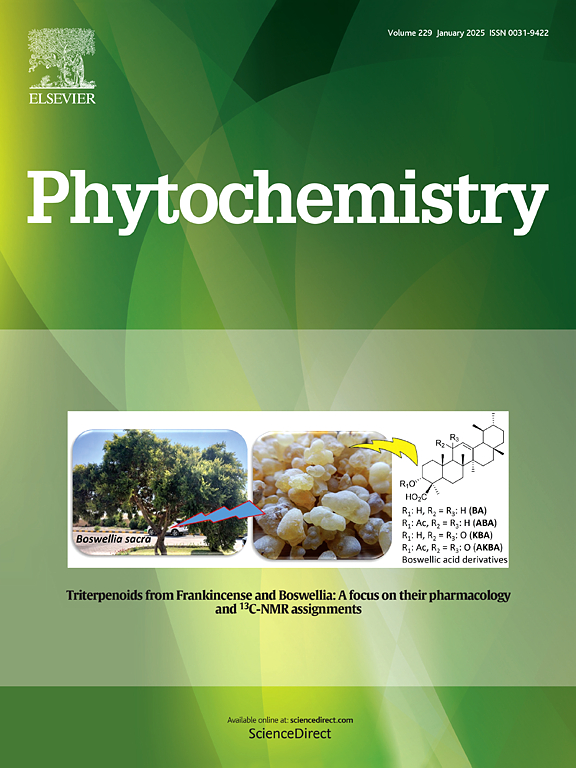五种未描述的具有细胞毒性和抗菌活性的绿灰青霉-苯吡啶酮杂合体。
IF 3.2
2区 生物学
Q2 BIOCHEMISTRY & MOLECULAR BIOLOGY
引用次数: 0
摘要
5个先前未被描述的苯吡啶酮,被命名为柠檬酸酮H-L(1-5),以及7个已知化合物,从金针菇来源的内生真菌青霉草的水稻培养基中鉴定出来。通过对UV、NMR和HR-ESI-MS数据的详细解释,阐明了它们的结构。化合物1-4中C-2和C-3的绝对构型通过光谱分析和ECD计算确定,C-5的构型通过计算13C NMR和DP4+分析确定。这些化合物代表了一种新的铬-苯基吡啶酮杂交体支架,这是青霉菌属中第二次报道这类化合物,也是第一次在C-2位置上具有独特的(E)-5-甲基庚-1,3-二烯基团。此外,本文还首次提出了这些新型铬-苯吡啶酮的生物合成途径。值得注意的是,化合物3和4在与HCT116和H1299细胞株联合使用时表现出细胞毒性,IC50值分别为4.15±0.34和9.07±1.64 μM。此外,化合物3、4和5对金黄色葡萄球菌具有显著的抑制作用,其MIC值分别为64、64和8 μg/mL。本文章由计算机程序翻译,如有差异,请以英文原文为准。

Five undescribed chromone-phenylpyridone hybrids from Cineraria repanda-derived Penicillium oxalicum with cytotoxic and antibacterial activity
Five previously undescribed phenylpyridones, designated as citridones H–L (1–5), along with seven known compounds, were characterized from the rice medium culture of the Cineraria repanda-derived endophytic fungus Penicillium oxalicum. Their structures were elucidated through detailed interpretation of UV, NMR, and HR-ESI-MS data. The absolute configurations of C-2 and C-3 in compounds 1–4 were determined by spectroscopic analysis and ECD calculations, while the C-5′ configurations were established through computational 13C NMR and DP4+ analyses. These compounds represent a novel scaffold of chromone-phenylpyridone hybrids, making only the second report of such compounds from the Penicillium genus and the first to feature a unique (E)-5-methylhepta-1,3-diene group at the C-2 position. Additionally, a biosynthetic pathway for these novel chromone-phenylpyridones is proposed for the first time. Notably, compounds 3 and 4 exhibited cytotoxicity against HCT116 and H1299 cell lines when used in combination, with IC50 values of 4.15 ± 0.34 and 9.07 ± 1.64 μM, respectively. Furthermore, compounds 3, 4 and 5 demonstrated significant inhibitory effects against Staphylococcus aureus, with MIC values of 64, 64 and 8 μg/mL, respectively.
求助全文
通过发布文献求助,成功后即可免费获取论文全文。
去求助
来源期刊

Phytochemistry
生物-植物科学
CiteScore
6.40
自引率
7.90%
发文量
443
审稿时长
39 days
期刊介绍:
Phytochemistry is a leading international journal publishing studies of plant chemistry, biochemistry, molecular biology and genetics, structure and bioactivities of phytochemicals, including ''-omics'' and bioinformatics/computational biology approaches. Phytochemistry is a primary source for papers dealing with phytochemicals, especially reports concerning their biosynthesis, regulation, and biological properties both in planta and as bioactive principles. Articles are published online as soon as possible as Articles-in-Press and in 12 volumes per year. Occasional topic-focussed special issues are published composed of papers from invited authors.
 求助内容:
求助内容: 应助结果提醒方式:
应助结果提醒方式:


